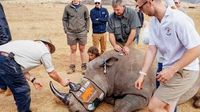In a groundbreaking effort to combat the relentless poaching crisis threatening rhinos in South Africa, the University of the Witwatersrand has launched the Rhisotope Project, a pioneering initiative that injects rhino horns with harmless radioactive isotopes. This technology enables customs agents worldwide to detect and intercept illegally trafficked horns, marking a significant advance in conservation tactics.
The project, officially launched on August 1, 2025, follows extensive trials conducted in 2024 where about 20 rhinos at a sanctuary were injected with these isotopes. This pilot phase demonstrated that the radioactive material is safe for the animals and effective in triggering radiation detectors at airports and border checkpoints. Five rhinos were injected during the launch event, with hopes to expand the program to cover South Africa’s entire rhino population.
James Larkin, chief scientific officer at the Rhisotope Project and director of the Radiation and Health Physics Unit at the University of Witwatersrand, explained the process: “We’re putting small amounts of radioactive material into the horns of the rhino, making sure that it doesn't harm these animals. It makes it so much easier to detect these horns as they're moved across international borders.” He added, “Even a single horn with significantly lower levels of radioactivity than what will be used in practice successfully triggered alarms in radiation detectors.”
The procedure involves sedating the rhino, drilling a small hole into its horn, injecting a carefully selected radioisotope in a couple of places, sealing it up, and then reversing the tranquilizer. The rhino is then free to roam, carrying the radioactive marker for up to five years. The entire process is quick and minimally invasive, ensuring the welfare of the animal.
South Africa is home to the largest rhino population globally, with approximately 16,000 individuals. However, the country faces a severe poaching crisis, with about 500 rhinos killed annually for their horns since 2021. These horns fetch exorbitant prices on the black market—up to $60,000 per kilogram, more valuable than gold—fueling a $20 billion global illegal trade, primarily destined for Asian markets where the horns are prized for traditional medicine and status symbols.
Arrie Van Deventer, founder and managing director of the Rhino Orphanage, hailed the Rhisotope Project as potentially the “holy grail” for rhino conservation. “Now, with the Rhisotope Project, you can’t take that horn anywhere. It is radioactive. You can’t take it through any airport, any harbor, any customs office. Sirens go off. It is wonderful, I’m telling you. This could be the holy grail to save the species,” he said.
The International Atomic Energy Agency (IAEA) has been a key partner in the project, lending its expertise and infrastructure. Rafael Mariano Grossi, the IAEA director general, emphasized the novel use of nuclear science: “Illegal poaching is driving the rhinoceros towards extinction. In South Africa, one rhino is killed every day. The Rhisotope Project is using nuclear science to make that stop.” He further noted, “By using already installed nuclear security infrastructure in novel ways, we can help protect one of the world’s most iconic and endangered species.”
Testing revealed that the radioactive isotopes can be detected even when horns are hidden inside full 40-foot shipping containers, a common tactic used by traffickers. This detection capability promises to disrupt the illegal trade routes effectively, assisting law enforcement in making arrests and seizing contraband.
While the Rhisotope Project offers a promising new tool, conservationists acknowledge it is not a silver bullet. Jamie Joseph, director of the charity Saving the Wild, praised the initiative as “much needed” but cautioned that “only better legislation and political will can bring an end to the rhino crisis.” He added that the project will help experts “better map out the illegal channels by providing reliable data,” which is crucial for strategic interventions.
Other anti-poaching methods have been trialed with mixed results. A 2024 study found that de-horning rhinos reduced poaching by 78 percent, although a 2023 study suggested that de-horning could alter rhino behavior, causing them to socialize less. Additionally, conservationists have proposed dyeing rhino horns and elephant tusks bright pink to deter poachers, but these methods have yet to gain widespread adoption.
The International Union for Conservation of Nature (IUCN) estimates the global rhino population has plummeted from around 500,000 at the start of the 20th century to just about 27,000 today. The stark decline underscores the urgency of innovative conservation strategies like the Rhisotope Project.
James Larkin underscored the pressing nature of the crisis: “At least one animal a day is still being poached. I think the figures are only going to go one way if we don’t watch out. This is a significant tool to help reduce the numbers of poaching because we’re proactive rather than being reactive.”
Jessica Babich, head of the Rhisotope Project, expressed optimism about the future, saying, “Our goal is to deploy the Rhisotope technology at scale to help protect one of Africa’s most iconic and threatened species. By doing so, we safeguard not just rhinos but a vital part of our natural heritage.”
The Rhisotope Project represents a remarkable fusion of nuclear science and wildlife conservation, leveraging existing global nuclear security infrastructure to tackle wildlife trafficking—a crime that threatens biodiversity and the survival of species worldwide.
As the world watches this initiative unfold, the hope is that it will mark a turning point in the fight against rhino poaching, offering a blueprint for similar efforts to protect other endangered species such as elephants and pangolins. The collaboration between scientists, conservationists, and international agencies exemplifies the innovative spirit needed to address complex environmental challenges in the 21st century.





